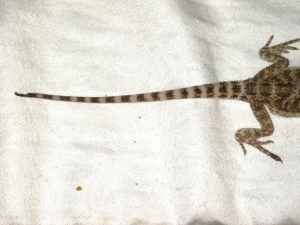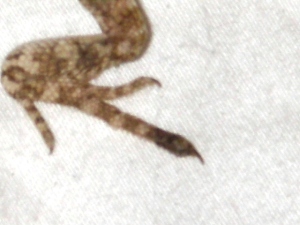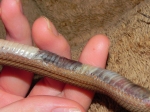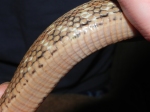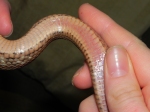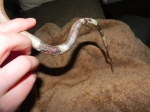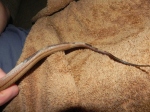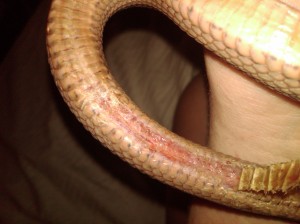
Flo, Taken From Us Way To Early in July 2008
Back in June 2008, I purchased my first bearded dragon. I have always been fascinated by reptiles but I had never had the opportunity to explore or research them. When I was a child, I asked my parents if I could have a snake but they said “no” and pointed out that I could do anything I wanted when I moved out. Finally, 18 came and left and I was preoccupied with college and guys. When I was 19, I met Chris, my current fiance, and although we moved in together and took on cats, chinchillas, and even ferrets, it still did not come across my mind that reptiles could actually be great pets. I had heard stories of people having reptiles before and of they dying from x, y, or z, or that they need all this complicated lighting and heating. I truly thought you had to be some sort of specialist to have one! I was in the dark, my familiarity only in keeping fuzzy pets.
[Side note: I am greatly disappointed that my parents stifled my explorations with reptiles. If they had encouraged it, I would be in a different career with a different lifestyle. I didn’t know WHO I was until recently, and I feel like I would have known much sooner had they encouraged me. But that’s a story for
another post and another day but a piece of my heart that I want my readers to know.]
Time came and went. Then, in July 2008, I was 22, had started experiencing life a bit, completed my
undergraduate education, already had a half-year of professional work experience under my belt, and I had a significant change in thought process. I had been on vacation to Cancun and Punta Cana within that year and had a lot of exposure to reptiles in the wild. In Punta Cana, I had a special experience where we essentially bribed (shh!) the zookeeper to take us into the Rhino Iguana den. It was a big, rocky area with at least 50-100 iguanas running around, whizzing past me. I even held one of them but was very frightened and couldn’t understand why. I actually have a few videos of this on YouTube. Here is one and you can link to the others on my YouTube Channel: My Girlfriend in a Rhino Iguana Den.
A month after I came back from Punta Cana, I was beginning to realize that this fear that I had of them was mostly from my parents making me think that they were something to be feared. The fascination in me told me I wanted more. During this month, I sat by a pool with my fiance, and randomly said, “can we go to PetSmart and get a lizard?” Of course, he seemed to think I was joking. Then, when he realized I wasn’t, he said the smart thing, “Why don’t we research it a little more this week and then go get one next weekend?”
“No, I want it now,” I responded like the brat I am.
We stopped at the store and I picked out a cute baby bearded dragon. Still, I had NO idea what he
needed. Looking back, I wish I had listened to Chris. –but, I am stubborn. At the store, I had to rely on
the information provided to me by an inexperienced clerk who worked in the reptile section. She said we would need a hide box, a heat light, a night light, a water dish, substrate, etc. She neglected to mention the UVB, the most ESSENTIAL part of a lizard’s setup! I passed by the UVB tube lights and I asked her about them and she said, “no, you do not need those.”
I forgot how it first came up but my gut told me that something was amiss. I asked Chris to
take the new beardie, now named Flo (because of his easy-going attitude), to the exotic vet in NYC a few days later just to be 100% sure that we had the setup right and we weren’t missing anything. He was eating fine and everything but I just wasn’t sure. I also noticed that he had some odd spots on him that were yellowish.
Chris reported back from the vet that the Flo, and most other lizard species for that matter, NEED UVB!
It is 100% essential for processing food properly. Good thing we went to the vet that soon.
Regarding the spots, the inexperienced vet said, “oh, they look like they just might be burns or blisters. Put this cream on them and he will be fine.”
I didn’t think this seemed normal so I started researching online and came across a wonderful forum dedicated to bearded dragons: Bearded Dragon.org. That is when I first learned of the infamous Yellow Fungus Disease that can spread like rapid fire, especially in pet stores. Little beardies that get infected with this sadly do not make it in most cases. Beardies that are a bit bigger seem to have a better chance of recovery. Anyway, so I thought this could be what it is and had Chris take Flo back to the vet.
The vet STILL insisted that it wasn’t Yellow Fungus. The fact of the matter is, she was just out of vet school and had no f-ing idea what she was doing, in most cases. My memory is a little hazy around this period of time because I was so overcome with grief, I think I blacked part of it out. She thought that at most it was an infection and gave him some sort of antibiotic…
During this period of time we had to go to New Mexico because we had a pre-planned trip. I missed Flo that whole time and yearned to be with him just in case something went wrong. He was staying with the same vet in medical boarding. When I got back from New Mexico, I hurried to the vet to see Flo and thought that he would be better by then. Well, he looked sicker than ever before, lethargic, and it saddened me. The vet spoke with us and informed us that she thought he had Yellow Fungus and she had a few others come in with it during that week. Also, the pet stores that bring beardies to her were facing an outbreak at the time. As a result, she gave us another medicine to give him and instructed that we force feed him. My heart was broken. Nothing like “I told you so!” If she had treated him a week earlier when I initially suggested this, he would have had a better chance of making it. She even said that
the last medicine she gave him can exacerbate Yellow Fungus!
Never did she say “sorry” or “I made a mistake.”
We took him home that night and followed through with the medicine and tried to get him to eat. I just knew this was NOT good. He would not eat no matter what I did. It almost looked like he was falling into a comatose state. He was just such a small, little baby beardie who deserved a chance at life. He didn’t do anything wrong and was plagued by inexperienced handlers all the way through, from the breeders who mixed him with other sick beardies and then sold him to a petstore, to me and the store clerk, to the vet who made the mistake, he had a raw deal. If I had more experience, I would not have purchased him as I would have seen the signs. Although, then he would have never experienced love. At least he had someone who tried and cared about him. (And yes, I do believe reptiles know when you love them.)
My heart still hurts over this experience and just breaks. I am STILL mad at that vet. Would he still be here if she had trusted the petowner that something is wrong? To all the vets out there, take heed when a petowner tells you something because they know their own pets better than you do. Don’t discount them just because they didn’t go to school for veterinary medicine, they can still be intelligent people.
I don’t think I need to go further than to say that the next day I just knew that he would not be there in life by the time I got home from work. It was one of the most difficult nights of my life. I never would want to
relive that.
Because of this experience, I am going to share with you everything I wished I knew before becoming a mother to reptiles. I now had the basics down after my experience with Flo but it has been a learning experience all the way through. I am going to condense the most important things that I learned in my near 4-years of experience with many different types of reptiles (tegus, beardies, iguanas, snakes) into my next blog entry: Things I Wish I had Known About Reptile Care From The Beginning.
This is for Flo. R.I.P., my love.
______________________________________________________________________________________________________
To read more about how the symptoms and treatment of Yellow Fungus Disease, please view our post: Yellow Fungus Disease (YFD)/Nannizziopsiosis

